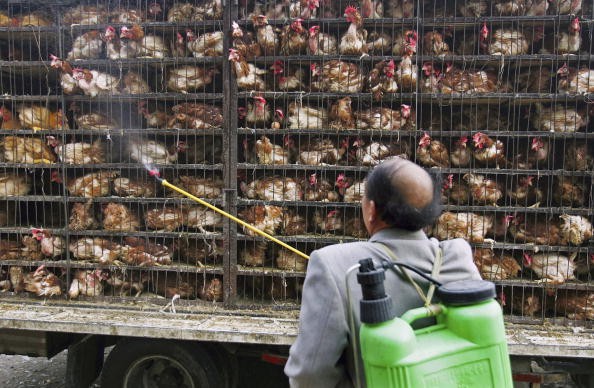The World Health Organization (WHO) now warns of Bird Flu's possibility to jump to humans after H5N1 influenza recently started spreading to other mammals.
WHO notes that the risk of transmission to humans remains to be low. However, the health organization still wants us to prepare. Perhaps to avoid another pandemic from affecting our lives.

(Photo : China Photos/Getty Images)
A worker disinfects chickens transported to a chicken slaughtering factory on May 4, 2006 in Xining of Qinghai Province, China.
WHO Warns Bird Flu's Possible Human Transmission
According to a report by Reuters, the H5N1 influenza, aptly known as bird flu, has recently started spreading to mammals, specifically otters, mink, and sea lions.
And as such, the WHO now warns about the low risk that bird flu starts spreading to humans as well.
The Director General of WHO, Tedros Adhanom, notes that H5N1 has long been spreading among wild birds and poultry like chickens in the past two decades. That's why it got its "bird flu" moniker.
However, after roughly 25 years, the bird flu is reportedly no longer exclusive to poultry and wild birds. The WHO Director-General notes that they will be closely monitoring recent reports of H5N1 infections in mammals like otters and mink.
Despite the reports of mammal transmission, Adhanom believes that the possibility of the bird flu jumping to humans remains low.
The WHO Director-General adds that human cases are still rare since avian influenza emerged in the 90s.

(Photo : MATTHEW HATCHER/AFP via Getty Images)
Casim Abbas, a mathematics professor at Michigan State University, feeds chickens at his small egg farm at his home in Williamston, Michigan, on February 8, 2023. - Due to the ongoing egg shortage and the rise in prices due to avian flu, some people in the US are turning to local farms and backyard operations to purchase their eggs.
However, WHO still warned about the low risk of human transmission. Its Director-General warns that "we cannot assume that will remain the case."
And as such, he urged us to prepare for the day that the low risk of human transmission changes. Adhanom says "we must prepare for any change in the status quo."
Bird Flu Spreading to Mammals
While the avian flu used to spread only to birds. Gizmodo notes in its report that times have seemingly changed. There are now a series of outbreaks of mammals.
For instance, in the United Kingdom, transmission has spread to foxes and otters. Meanwhile, three grizzly bears reportedly got bird flu in Montana.
On the other hand, Peru confirmed that they detected the avian flu in other mammals, such as dolphins and sea lions. Minks also reportedly had an outbreak in Spain.
Gizmodo highlights that the transmission to minks is quite alarming. It turns out that these semi-aquatic mammals feature respiratory tracts that are close to what humans have.
But despite that, WHO maintains that the risk of transmission of bird flu to humans remains low. However, it could still possibly change over time. So the health organization urges us to be prepared.
Related Article: Dirty Money! WHO Warns Banknotes May Pass Coronavirus; Looks Towards Cashless Transactions






